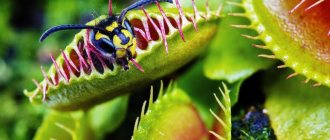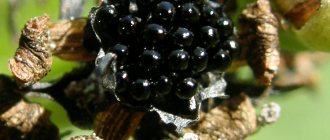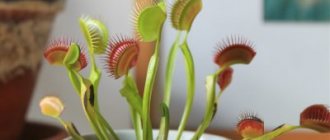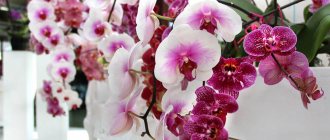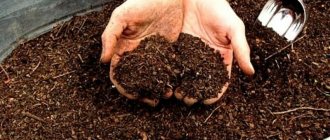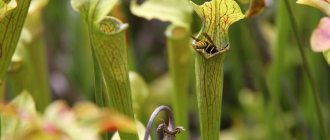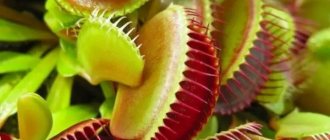Home page Wildlife World of plants
85 550 4.26 12
The Venus flytrap, or Dionaea muscipula, is a carnivorous plant that grows in the peat bogs of pine forests in the eastern United States, near the Atlantic Ocean, where the climate is humid and temperate. It became carnivorous in the process of evolution due to a lack in the soil of the main nutrients necessary for the growth and development of the plant.
How does a Venus flytrap hunt?
The soil on which the Venus flytrap grows is deficient in nitrogen, and its balance is shifted to the acidic side. Without a sufficient supply of nitrogen to the plant body, it is difficult for the plant to synthesize proteins and thereby continue to grow. Therefore, to replenish nitrogen reserves, the Venus flytrap hunts insects and digests them. This means that every fly or ant caught and digested by this plant acts as a nitrogen fertilizer, stimulating the growth and development of Dionaea muscipula.
The Venus flytrap hunts for insects with the help of leaves (the plant has 4 to 7 of them), which have a unique structure. A plant leaf has two main areas:
- The wide part is called the base of the leaf. All conditions for photosynthesis and nutrition through the root system are present here.
- The part that acts as a trap is called the leaf blade.
The blade is located along the edge of the leaf, which consists of two halves connected by a longitudinal vein. Each flycatcher trap has two to five "trigger hairs" on each lobe (there are usually three). Along the edge of the blade there are teeth shaped like fingers. In Latin they are called cilia. When the trap slams, these fingers intertwine. The base of the leaf and the blade (trap) are connected by a part called the petiole (a botanical term for the stem part of a leaf).
How to grow bonsai at home?154013.567
Preservation and distribution
The Venus flytrap primarily grows in a small area less than 100 miles around the city of Wilmington in the US state of North Carolina. The greatest threat to the conservation of the species comes from the illegal collection of wild plants for trade. The Venus flytrap is listed in Appendix II of the Convention on International Trade in Endangered Species of Wild Fauna and Flora, and is also listed in the Red Book of the International Union for Conservation of Nature.
Closing mechanism
The top of each side of the Venus flytrap trap is colored with anthocyanins, pigments that give the surface of the trap a red color. This coloring is the main bait for insects in this plant. The trap cells also secrete a sticky substance, which is a type of protein. After the insect crawls into the trap, it begins to flounder on the slippery and sticky surface, greedily licking off the substance, touching the trigger hairs that signal the trap to slam shut.
The trap closing mechanism of the Venus flytrap can be divided into four main phases:
- Initial slamming.
- Compression phase.
- Sealing phase.
- Re-opening phase.
The "descent hairs" are indicators for the plant, which by their vibrations determines that potential prey is trapped. If two hairs are touched at once or one hair twice in a row within 30 seconds, the trap slams shut in a tenth of a second.
The slamming motion of a Venus flytrap is one of the fastest movements that plants are capable of. The amount of time it takes for Dionaea muscipula to slam shut varies greatly depending on ambient temperature, light, plant health, and other factors. However, the trap of a healthy plant in warm conditions slams shut very quickly.
The details of the slamming process are actually quite complex. Scientists are currently researching this process and have put forward various hypotheses, which include an instantaneous increase in cell size and an "unstable latch state" that are under the control of this plant.
Recent research conducted in 2005 by Harvard scientists shows that the Venus flytrap's trap slamming mechanism is based on biochemical and elastic processes. They cause the leaf tissue to stretch to the point of instability, and after touching the hairs, the plant instantly pumps water into the leaf, causing slamming.
What does a predator flower look like?
Outwardly, this is not a particularly noticeable plant, one might say, a grass. The largest size that ordinary leaves can have is only 7 centimeters. True, the stem also contains large leaves that appear after flowering.
The inflorescence of a Venus flytrap is somewhat similar to the flowers of an ordinary bird cherry. This is the same white delicate flower, with a large number of petals and yellow stamens. It is placed on a long stem, which grows to such a size for a reason. The flower is deliberately placed at a large distance from the trap leaves so that pollinating insects do not get into them.
The Venus flytrap grows in marshy areas. The soil here does not have a lot of nutrients. It is especially low in nitrogen, which is what is needed for the normal growth of most plants, including flycatchers. The process of evolution went in such a way that the flower began to take its food not from the soil, but from insects. He has developed a cunning trapping apparatus that instantly locks in a suitable victim.
Compression phase
If the initial slam of the trap is successful, the compression phase begins, which lasts about half an hour. The process looks like this. During the struggle, the insect inside the trap continues to touch the “trigger hairs.” This signals the flycatcher that it needs to further clamp the flaps to keep the victim inside. If the insect is small enough, it can slip through the teeth of the trap and escape.
The compression phase does not occur if the slamming is unsuccessful in finding prey. This happens if, when the flaps collapse, the insect manages to get out of the trap or vibrations of the hairs occur, caused by other leaves, raindrops, or a person who stuck his finger there. Then the trap begins to slowly open and opens completely in a day or two. But if such touching of the hairs occurs several times, it can lead to blackening and death of the trap. In subsequent times, the rate of collapse of the same trap drops significantly.
Diseases and pests
Who would have thought that a plant that can eat insects could also suffer from them? There have been cases when aphids infested the surfaces of traps, causing them to become deformed. Special insecticides are sold against small insects. The predatory flycatcher flower can also be affected by spider mites: treatment with an acaricide solution will help destroy the pest.
Dionaea needs special care: where it grows, it is necessary to maintain optimal air humidity and temperature conditions. However, if the soil is too wet, the flower may suffer from sooty fungus - a black coating will appear on the leaves and stems. Fungicides will help fight it. If the maintenance conditions are not met, the flytrap is attacked by botrytis - a gray fluff of mold. If you notice the appearance of such mold, immediately remove the affected parts and treat the plant itself with a fungicide solution.
Bactericidal damage to Dionaea can also occur due to the fact that the trap cannot cope with digesting the caught insect. In such cases, the closed petals turn black and rot, and the disease quickly spreads throughout the plant. You need to immediately cut off the damaged trap, and then treat the flower with a fungicide solution.
Sealing and opening phases
If the trap successfully captures the prey and the insect does not escape before the compression phase begins, the sealing phase begins. During this phase, the teeth of the trap move forward and outward so that they no longer intertwine. As a result, the edges of the flytrap lobules (blades) on both sides are tightly pressed against each other. When the seal becomes dense and impenetrable, digestive enzymes begin to be released. The insect drowns in them and is gradually digested.
Over the next 5-12 days, the trap remains closed during digestion. At this time, digestive enzymes continue to be released, dissolving the soft tissues of the insect. The nutrients contained in the tissues of the insect are released in a form in which the flycatcher leaf can absorb them.
The amount of time required to completely digest the prey depends on the age of the insect, the trap, and the ambient temperature. The larger the insect, the longer digestion takes. The older the trap, the slower the digestive enzymes are released; the warmer the weather, the faster digestion occurs.
For an ideal “lunch,” the insect should be one-third the size of the trap. If the insect is too large or any part of it is hanging out of the trap, the seal may not be tight. Because of this, the trap may die. It turns black, dies and falls off the plant. The base portion of the leaf will continue to supply energy to the plant through photosynthesis, but it will no longer grow new serrated blades capable of hunting.
After finishing lunch, the leaf absorbs substances along with the digestive fluid that the plant received as a result of digesting the prey. This signals the plant to open the trap again. All that remains by this time after lunch is the exoskeleton of the insect. It can be washed away by rain, blown away by the wind, but it can also serve as bait for the next victim. Very often, spiders or ants are lured by the corpse, which ends up being the next meal for the Venus flytrap.
After several successful hunts in a row, the trap stops functioning. The plant itself lives much longer: under favorable conditions, it can function for twenty years.
How does a plant reproduce?
The flycatcher reproduces in different ways - by cuttings, seeds or dividing the bulb. Obtaining Dionaea seeds is the longest and most complex process. As the flower grows, bulbs appear; they are cut off and replanted. Cuttings can also be cut and planted in the soil, after which you need to cover the pot with flower stalks with film. The flyeater reproduces when a certain temperature is maintained (no more than 25 degrees) and optimal humidity is provided.
To get sundew seeds, you need to pollinate its flowers yourself using a cotton swab or brush. If the process was carried out correctly, then within a month small boxes with seeds will appear. They need to be sown three months after pollination, otherwise germination is then lost.
When planting, scatter the seeds over the surface of the soil and spray with soft water using a spray bottle. Do not forget to comply with the requirements for placing crops - place the containers in the greenhouse under bright, diffused sunlight or artificial light. Maintain the room temperature at about 24-29 degrees, make sure the soil is always moist.
From Dionea you need to carefully cut off one leaf and process the cut using Kornevin. Having placed the cutting at an angle, plant it in a substrate of peat and quartz sand. After this, you can cover the container with a transparent cap and leave it at room temperature under bright light until the cuttings begin to sprout – this often happens after three months. Remember that rooting is not recommended, otherwise the cuttings may be affected by fungi.
Dividing the bush
Propagating flycatchers using this method is much easier. It is best to do this during transplantation of Dionea: a flower 1-2 years old is removed from the pot, then the roots are freed from the soil and the daughter rosettes are separated from the adult plant using a sterile instrument. After this, the rosettes are planted in separate pots, put away in partial shade until they take root in the new substrate.
Popular message topics
- City of Magnitogorsk
Magnitogorsk is a very small town in the Chelyabinsk region, which is famous for its metallurgical achievements (for which it was called the “capital of metallurgists”), plants, factories, but besides this it is also rich in cultural things, - City of Samara
Ah, Samara is a town,……. How many songs have been written, how many poems have been written about such a beautiful city in the Volga region - Samara. The city is truly beautiful in its own way, it is the pearl of the Volga region, having a rich historical heritage of Russia. - Phoenician sailors
About 4,000 years ago, the eastern shore of the Mediterranean Sea became an excellent home for tribes, which the Greeks later called Phoenicians. From the very beginning, the country of Phenicia occupied a small part of the territory between the Lebanese mountains and the sea.


